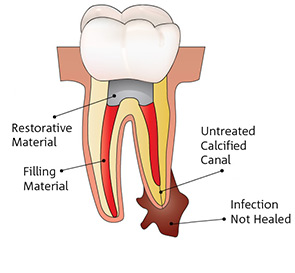Root Canal Treatment
Root canal therapy is the most commonly performed endodontic procedure.
Everything you need to know about root canal treatment
Root Canal Treatment is the most commonly performed endodontic procedure, and is used to save a badly infected or damaged tooth that would otherwise need to be removed.
When the dental pulp is damaged, bacteria can start to multiply inside the tooth, potentially leading to an infection or abscess, which is a pocket of pus that forms at the end of the tooth’s root.
Sometimes there are no symptoms that a tooth needs root canal therapy.
However, some warning signs include;
- Severe toothache when chewing
- Sensitivity to hot or cold that lasts after the heat or cold has been removed
- Darkening of the tooth
- Swollen and tender gums
- Persistent pimple on the gums or a hole in the tooth
- Swelling of the face or neck
What is involved with root canal treatment?
Root Canal Therapy (also called endodontics) can be carried out over one to two visits, depending on the health of the tooth and the complexity of the root canals, and in most instances is no more painful than a normal filling.

First, the dentist takes an x-ray of the tooth to see the shape of the root canals and determine whether there is any infection in the bone around the tooth. A root canal treatment involves shaping and disinfection of the inside of the tooth; drilling a hole into a decayed tooth and removing the soft centre, known as the dental pulp. Before commencing treatment, the tooth is generally numbed using local anaesthetic, before drilling a hole in the tooth to remove the pulp. The tooth, and adjacent teeth are then isolated using a dental dam to keep contaminating saliva away from the root canals.
The procedure itself usually involves making a small hole in the tooth in order to reach the pulp, however, this can be a more extensive procedure if there is additional decay that must be removed or if cracks begin to show in the teeth. It is common to use a microscope for these procedures to inspect the tooth closely, and to remove only the minimum amount of tooth structure. The canals are then disinfected with antibacterial fluids, before specially designed instruments are used to gently, but thoroughly, remove the pulp and shape the canals. After this, a medication is placed in the canals to eliminate any germs that may remain, and the tooth is sealed until the next appointment.
Once the canals are shaped and cleaned they are filled using a rubber compound called gutta percha, which creates a plug in the canal to prevent germs from re-infecting the area. From here, the gutta percha is cemented using a biocompatible sealer to make up the root canal filling. After the canal is filled a temporary filling is placed in the tooth, and a final X-ray is recorded showing the finished root filling. This will accompany a report to your dentist outlining all treatment and what needs to be done next.

Request an Appointment
Fill out the form below and we’ll get back to you as soon as possible.
